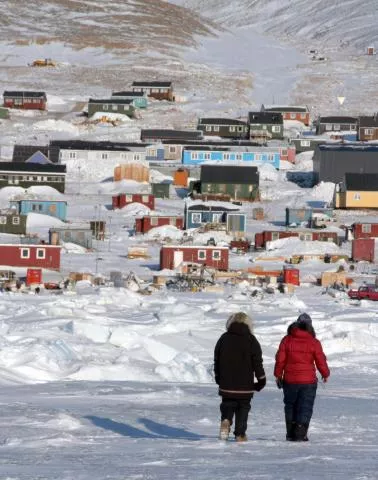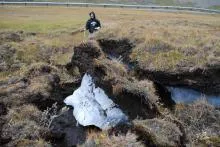The National Snow and Ice Data Center (NSIDC) is part of the Cooperative Institute for Research in Environmental Sciences at the University of Colorado Boulder.
Greenhouse gas emissions from thawing Arctic permafrost could result in an additional $43 trillion in economic impacts by the end of the twenty-second century, according to a new study by researchers from the University of Cambridge and the National Snow and Ice Data Center (NSIDC). These extra impacts justify the need for urgent action to reduce emissions from thawing permafrost. The study was published today in the journal Nature Climate Change.
Permafrost or frozen ground, which contain about 1,700 gigatons of carbon in the form of frozen organic matter, have begun to thaw in response to Arctic warming over the past few decades. As the permafrost degrades, carbon dioxide and methane are released, amplifying the effects of emissions from human activity.
Researchers Chris Hope of the University of Cambridge and Kevin Schaefer of NSIDC modeled the range of possible global economic impacts of permafrost emissions under various Intergovernmental Panel on Climate Change (IPCC) scenarios.
“We want to use these models to help us make better decisions—linking scientific and economic models together is a way to help us do that,” Hope said. “We need to estimate how much it will cost if we do nothing, how much it will cost if we do something, and how much we need to spend to cut back greenhouse gases.”
Under the A1B scenario, which assumes rapid economic growth and projects increased anthropogenic emissions until the atmospheric concentration of carbon dioxide reaches about 700 parts per million in 2100, the authors assumed zero anthropogenic emissions after 2100. They found that the total, cumulative permafrost emissions raise the economic impacts of climate change by 2200 from $326 trillion to $369 trillion, an increase of 13 percent.
This suggests that policies aimed at reducing emissions as soon as possible from thawing permafrost could substantially reduce the economic impacts of climate change.
“Reducing fossil fuel emissions and stopping climate change is not a stark choice between jobs and the environment,” Schaefer said. “Rather, we can simultaneously reduce emissions and grow the economy by harnessing the same market forces that created the problem in the first place.”
Schaefer added, “We need to invest to reduce the costs of renewable energy production and the costs of energy conservation and create the optimal policy setting with tax incentives and other means. This will create an environment where consumers will naturally choose the low-carbon option because it is the best economic choice available.”
Reference
Hope, C. and K. Schaefer. 2015. Economic impacts of carbon dioxide and methane released from thawing permafrost. Nature Climate Change. http://dx.doi.org/10.1038/nclimate2807.
Media contacts
Natasha Vizcarra
Media Liaison, National Snow and Ice Data Center
+1 303.492.1497, press@nsidc.org
Sarah Collins
Office of Communications, University of Cambridge
+44 (0)1223.765542, sarah.collins@admin.cam.ac.uk
-end-

